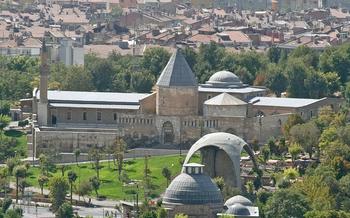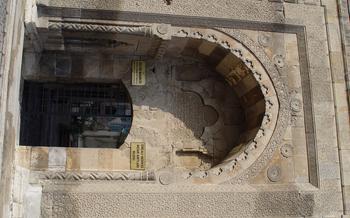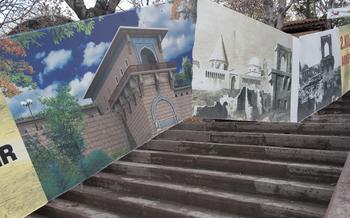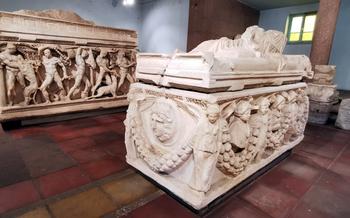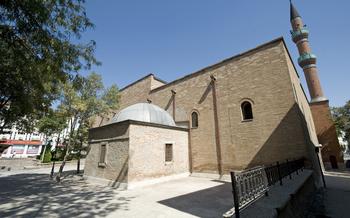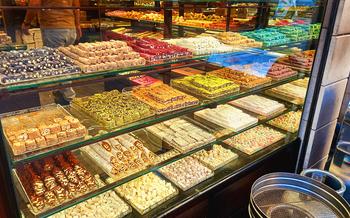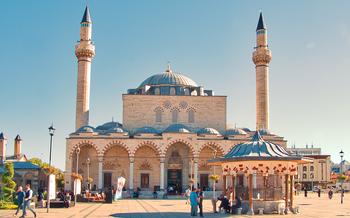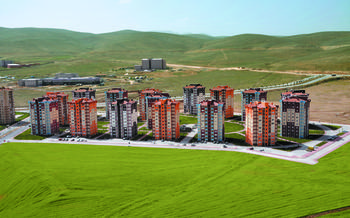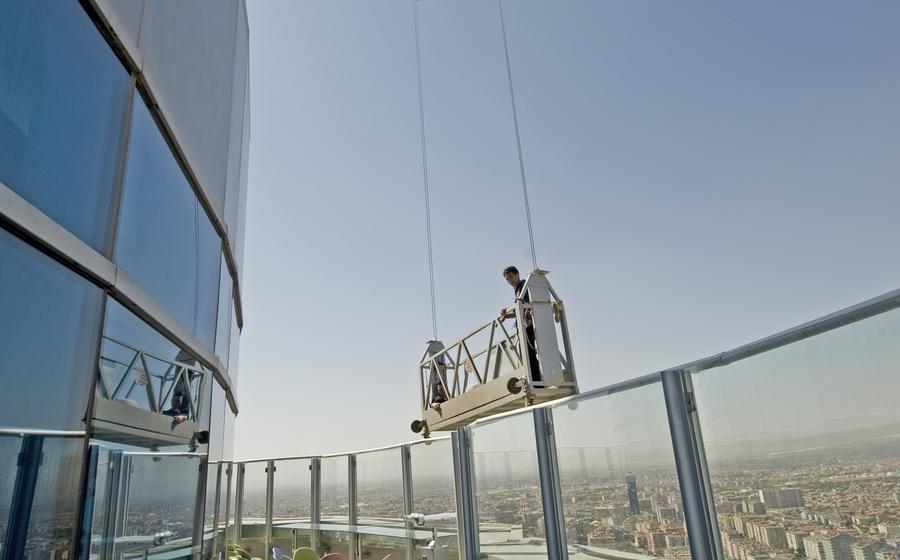
Seljuk Tower
- A Journey to History
- Architectural Marvel
- A Royal Observatory
- Landmark of Konya
- Historical Significance
- Unique Features
- Scientific Achievements
- Visitor Information
- Immersive Experience
- Stunning Views
- Explore Konya
- Cultural Significance
- Photography Paradise
- Local Legends
- Insider Tip
A Journey to History
The Seljuk Tower, also known as the Green Tower, stands as a testament to the rich history of Konya. Built in the 13th century during the reign of Sultan Alaeddin Keykubad I, the tower served as a watchtower and an astronomical observatory. Its strategic location on a hilltop provided an unobstructed view of the surrounding landscape, making it an ideal spot for observing the stars and monitoring the movement of enemies.
The tower's distinctive green hue, which earned it the nickname "Green Tower," is attributed to the glazed tiles that once adorned its exterior. While many of these tiles have since been lost, the remaining fragments provide a glimpse into the tower's former grandeur. According to legend, the tower was built using a special type of mortar that contained crushed emeralds, giving it a unique greenish color.
One of the most captivating legends associated with the tower tells the story of its architect, who is said to have been blinded after completing the project to prevent him from replicating its design elsewhere. Despite his tragic fate, the architect's ingenuity and skill are immortalized in the tower's intricate carvings and exquisite craftsmanship.
Over the centuries, the Seljuk Tower has become an enduring symbol of Konya, representing the city's rich architectural heritage and its significant role in the history of the Seljuk dynasty.
Architectural Marvel
The Seljuk Tower stands as a testament to the ingenuity and craftsmanship of its builders. Its unique architectural features, blending Seljuk and Anatolian styles, make it a true masterpiece. The tower's octagonal shape, reminiscent of a prism, adds to its distinctiveness. Intricate carvings adorn the exterior, showcasing the meticulous attention to detail that went into its construction. The decorative elements and patterns, inspired by Islamic art, add to the tower's visual appeal, creating a harmonious blend of aesthetics and functionality. The Seljuk Tower is not merely a historical monument but a work of art, a testament to the architectural prowess of the Seljuk dynasty.
A Royal Observatory
The Seljuk Tower was not merely a defensive structure; it also served as a crucial scientific center in the Islamic world. Its primary purpose was to facilitate astronomical observations, making it a significant observatory during the Seljuk era. The tower's strategic location offered astronomers an unobstructed view of the night sky, allowing them to study celestial bodies and track their movements with precision.
Using the tower as an observatory, Seljuk astronomers made significant contributions to the field of astronomy. They meticulously observed the stars, planets, and other celestial objects, recording their positions and movements. This data played a vital role in developing accurate calendars, predicting eclipses, and determining the exact time for religious observances.
Beyond its role in astronomy, the tower also served as a navigational aid. By observing the positions of celestial bodies, sailors and travelers could determine their location and navigate their way across vast distances. The tower's visibility from afar made it a crucial landmark for seafarers and land travelers alike, guiding them on their journeys.
The Seljuk Tower's contributions to astronomy and navigation were instrumental in advancing scientific knowledge and exploration during the Seljuk era. Its legacy as a scientific center continues to inspire and fascinate researchers and visitors alike, showcasing the remarkable achievements of the Seljuk astronomers.
Landmark of Konya
The Seljuk Tower stands as a prominent landmark in the heart of Konya, visible from various points throughout the city. Its towering presence dominates the skyline, symbolizing the rich history and cultural heritage of Konya. The tower has become an integral part of the city's identity, serving as a beacon of its past and a source of pride for its residents.
Over the centuries, the tower has witnessed the rise and fall of empires, the transformation of the city, and the ebb and flow of history. It has stood steadfast through times of war and peace, serving as a silent observer of Konya's ever-changing landscape. Today, the tower continues to captivate visitors with its architectural grandeur and historical significance, attracting tourists from around the world who come to marvel at its beauty and learn about its fascinating story.
Historical Significance
The Seljuk Tower stands as a testament to the power and grandeur of the Seljuk dynasty, which ruled over a vast empire in the 11th to 13th centuries. The tower's construction during the reign of Sultan Alaeddin Keykubat I exemplifies the dynasty's commitment to architectural innovation and scientific advancement. The tower's unique design and astronomical significance reflect the Seljuks' sophisticated understanding of mathematics, astronomy, and engineering.
The tower's architectural style, a blend of Seljuk and Anatolian influences, influenced subsequent architectural developments in the region. Its octagonal shape, intricate carvings, and decorative elements became hallmarks of Seljuk architecture. The tower's construction marked a turning point in Islamic architecture, showcasing the Seljuks' ability to synthesize diverse architectural traditions and create something truly unique.
Today, the Seljuk Tower stands as a UNESCO World Heritage Site, recognized for its exceptional cultural and historical value. It serves as a reminder of the Seljuk dynasty's contributions to Islamic civilization and its enduring impact on the architectural landscape of the region.
Unique Features
The Seljuk Tower stands out for its unusual octagonal shape, a distinctive feature that sets it apart from other towers in the region. This unique design adds to the tower's visual appeal and makes it a striking landmark in the Konya skyline. The tower's exterior is adorned with intricate tilework and carvings, showcasing the exceptional craftsmanship of the Seljuk artisans. The combination of glazed tiles and intricate stone carvings creates a mesmerizing effect, adding depth and texture to the tower's facade. Furthermore, the tower's blend of architectural styles, with influences from both Seljuk and Anatolian traditions, makes it a unique and fascinating example of Islamic architecture. Its octagonal shape, intricate tilework, and distinctive architectural style make the Seljuk Tower a truly remarkable and unforgettable sight.
Scientific Achievements
The Seljuk Tower played a pivotal role in the development of astronomy in the Islamic world. Seljuk astronomers used the tower as an observatory to study the stars, planets, and other celestial bodies. They made significant contributions to the field of astronomy, including the development of new instruments and observational techniques. The tower also served as a center for the transmission of astronomical knowledge to Europe, where it influenced the work of many European astronomers.
The tower's most famous astronomer was Ali Qushji, who lived in the 15th century. Qushji was a renowned astronomer and mathematician who made important contributions to the fields of trigonometry and astronomy. He wrote several influential works on astronomy, including the "Treatise on Astronomy" and the "Commentary on the Almagest". Qushji's work was translated into Latin and had a significant impact on the development of astronomy in Europe.
The Seljuk Tower remains a testament to the scientific achievements of the Seljuk dynasty. It is a reminder of the important role that Islamic astronomers played in the development of science and the transmission of knowledge.
Visitor Information
The Seljuk Tower stands tall in the heart of Konya, welcoming visitors from around the world. To ensure a smooth and enjoyable visit, here are some essential details to keep in mind:
Location: Located in the city center, the Seljuk Tower is easily accessible on foot or by public transportation. Its proximity to other historical sites makes it an ideal starting point for exploring Konya's rich cultural heritage.
Opening Hours: The Seljuk Tower is open to the public seven days a week. Visitors are welcome to explore the tower during the following hours:
- Summer Season (April to October): 8:00 AM to 7:00 PM
- Winter Season (November to March): 8:00 AM to 5:00 PM
Admission Fees: A nominal admission fee is required to enter the Seljuk Tower. The fees are as follows:
- Adults: 30 Turkish Lira
- Students: 15 Turkish Lira
- Children (under 12 years): Free
Guided Tours: Guided tours are available for visitors who wish to delve deeper into the tower's history and architecture. These tours are conducted by knowledgeable guides and provide insights into the tower's significance and role in Konya's development.
Other Facilities: To ensure a comfortable and informative visit, the Seljuk Tower offers several facilities for visitors, including:
- Information Center: A well-equipped information center provides visitors with brochures, maps, and other resources to help them plan their visit.
- Gift Shop: A gift shop located within the tower offers a variety of souvenirs, including books, postcards, and replicas of the tower itself.
- Restroom Facilities: Clean and well-maintained restrooms are available for visitors' convenience.
Immersive Experience
Visiting the Seljuk Tower is not just about admiring its architectural beauty or learning about its historical significance; it is about immersing yourself in a world of history, science, and culture. The tower offers a unique opportunity to experience firsthand the rich heritage of Konya and the Seljuk dynasty.
As you step inside the tower, you will be transported back in time. The ancient walls, intricate carvings, and decorative elements will captivate your senses and take you on a journey into the past. Imagine the Seljuk astronomers gazing up at the stars from the tower's observation deck, making groundbreaking discoveries that would shape the course of scientific knowledge.
The tower also provides a platform for cultural exchange and understanding. By learning about the tower's history and significance, visitors can gain insights into the diverse cultures and traditions that have shaped Konya and the surrounding region. The tower serves as a reminder of the shared heritage that connects people across borders and generations.
Whether you are a history buff, an architecture enthusiast, or simply someone who appreciates beauty and culture, a visit to the Seljuk Tower promises an immersive and unforgettable experience.
Stunning Views
The Seljuk Tower offers breathtaking panoramic views of Konya, providing a unique opportunity to see the city from above. From the observation deck, visitors can admire the city's landmarks, historical sites, and the surrounding landscape, which stretches for miles in every direction. The views are especially stunning at sunset, when the sky is ablaze with color and the city lights twinkle below. Whether you're a professional photographer or simply someone who enjoys capturing beautiful moments, the Seljuk Tower is a must-visit for anyone looking to experience the beauty of Konya from a new perspective.
Explore Konya
The Seljuk Tower is conveniently located in the heart of Konya, making it an ideal starting point for exploring the city's many other historical and cultural attractions. A short walk from the tower, visitors can discover the iconic Mevlana Museum, dedicated to the life and teachings of the renowned Sufi mystic Rumi. The museum houses a collection of Rumi's manuscripts, personal belongings, and other artifacts, providing a glimpse into the life of this influential figure.
Another must-visit site is the Alaeddin Mosque, one of the oldest and most significant mosques in Konya. Built in the 12th century, the mosque is a remarkable example of Seljuk architecture, featuring intricate carvings and a stunning interior. Visitors can admire the mosque's beautiful courtyard, adorned with a variety of trees and flowers, creating a serene atmosphere.
To experience Konya's vibrant atmosphere, take a stroll through the city's bustling bazaars and markets. Here, visitors can find a wide range of local handicrafts, souvenirs, and traditional Turkish delights. The bazaars are a great place to interact with the friendly locals and learn more about Turkish culture.
For those seeking a deeper dive into Konya's history and heritage, the city offers several museums and cultural centers. The Konya Archaeological Museum houses a vast collection of artifacts from various periods of the city's history, including the Seljuk and Ottoman eras. The Konya Ethnography Museum showcases traditional Turkish costumes, textiles, and household items, providing insights into the daily life of the people of Konya.
With its rich cultural heritage, Konya offers a plethora of experiences for visitors. Explore the city's historical sites, delve into its vibrant culture, and create lasting memories in this captivating destination.
Cultural Significance
The Seljuk Tower holds immense cultural significance as a testament to the flourishing Islamic culture during the Seljuk dynasty. It embodies the fusion of Islamic architectural and scientific achievements, showcasing the empire's commitment to knowledge and artistic expression. As a symbol of Konya's rich cultural heritage, the tower stands as a beacon of the city's identity and serves as a reminder of its contributions to the development of Islamic civilization.
The tower's architectural design reflects the blending of Seljuk and Anatolian styles, creating a unique and visually striking structure. Its intricate carvings and decorative elements showcase the artistry and craftsmanship of the Seljuk period, while its octagonal shape and innovative construction techniques demonstrate the ingenuity and engineering prowess of the Seljuk builders.
Beyond its architectural significance, the tower also played a crucial role in the development of Islamic science. The Seljuk astronomers used the tower as an observatory, conducting astronomical observations and making important contributions to the field of astronomy. Their work helped advance the understanding of the universe and contributed to the development of Islamic calendars and navigation systems.
The Seljuk Tower, therefore, stands as a symbol of Konya's cultural heritage, representing the city's commitment to knowledge, art, and scientific exploration. It serves as a reminder of the rich cultural tapestry of the Islamic world and the enduring legacy of the Seljuk dynasty.
Photography Paradise
The Seljuk Tower's captivating architecture and scenic vistas make it a photographer's haven. Shutterbugs will delight in the opportunity to immortalize the tower's splendor from various angles and under different lighting conditions. Experiment with wide-angle shots to capture the tower's full grandeur against the Konya skyline. Zoom in on the intricate details and carvings that adorn the tower's exterior to reveal its artistic mastery. Don't miss the chance to capture the tower's silhouette against the backdrop of a vibrant sunset, creating a breathtaking composition that will leave your viewers in awe.
Local Legends
The Seljuk Tower is shrouded in mystery and intrigue, inspiring countless legends and stories that have been passed down through generations. One of the most popular tales is that of the tower's architect, a brilliant and ambitious man who dedicated his life to creating this magnificent structure. According to legend, the architect made a pact with the devil to ensure the tower's completion, promising his soul in exchange for supernatural assistance. As the tower neared completion, the architect realized the gravity of his mistake and sought to repent, turning to God for forgiveness. In a fit of rage, the devil destroyed the scaffolding, causing the architect to fall to his death.
Another legend tells of a hidden treasure buried beneath the tower, said to contain vast riches and priceless artifacts from the Seljuk era. Treasure hunters have searched for centuries, but the treasure remains undiscovered, fueling speculation and excitement among locals and visitors alike. These legends add an enchanting aura to the Seljuk Tower, making it a captivating destination for those seeking a glimpse into Konya's rich cultural heritage.
Insider Tip
- Best time to visit: Aim for sunrise or sunset to capture the tower's beauty in golden light.
- Avoid crowds: Visit during weekdays or early mornings to enjoy a more tranquil experience.
- Perfect photo spot: Head to the nearby Alaeddin Hill for panoramic shots of the tower against the cityscape.
- Local flavors: Indulge in traditional Turkish cuisine at nearby restaurants like Ali Baba Konya Mutfagi or try the famous Konya pide (flatbread) at Pideci Remzi Usta.
- Hidden gems: Explore the Sille district for its charming historic houses and churches, or visit the Kubadabad Palace ruins for a glimpse into Konya's past.
